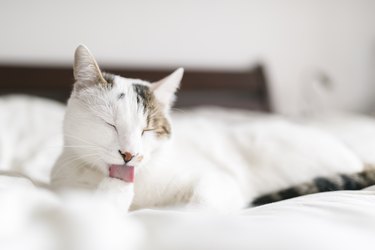Cats are playful and curious and may become injured in various ways. Wounds on cats can range from light scratches to deep lacerations and punctures. Whatever the cause, appropriate wound care for cats who have been injured is essential to prevent infection and promote healing.

Cat wounds, such as small abrasions or scratches, may heal on their own after being rinsed with fresh warm water. Nevertheless, your veterinarian is the best source of guidance on appropriate cat wound care. An injury may appear minor, as cats' natural instincts to not appear vulnerable to predators incline them to hide any pain. This can make it very difficult to ascertain the severity of a cat wound. If your cat is injured, see a veterinarian. It is always advisable to see a veterinarian to prevent complications that could harm your cat's health.
Video of the Day
Video of the Day
Types of cat wounds
Outdoor cats may encounter strange cats or other animals and receive bites. All cats can hurt themselves while exploring and playing if they come into contact with sharp objects or chemicals. Whatever the reason for your cat's injury, identifying and understanding the risks associated with each type of wound will help you decide the best course of action.
- Insect bites: Depending on where you live, the type of insect that can bite your cat and the risk they pose will vary. While most insect bites are minor, some can be very dangerous, resulting in swelling, infection, and in some cases, shock.
- Scratches: These can be caused by cats, other animals, contact with sharp plants, or an accident. Scratches can also be self-inflicted if the cat is suffering from itchy skin. In some cases, there will be bruising along with scratches, especially if caused by a trauma. If there is bruising, bleeding, swelling, or redness around a scratch, see a veterinarian. If a cat is scratching themselves, the underlying cause of the itching must be determined and treated.
- Abrasions: When the skin is scraped, it will leave an abrasion. These are usually superficial injuries caused by rubbing against a rough surface. Although they often heal well on their own, abrasions can occur when a cat has been hit by a car or dragged. It is essential to check and monitor your cat for any other symptoms if you notice an abrasion.
- Abscesses: Cats often get abscesses, which are an infection under the skin. These often happen after skin closes up over injuries like bites, trapping bacteria under the surface of the skin. Eventually, these become inflamed with pus and burst. They are painful, and the infection can cause systemic illness in the cat, leading to lethargy and fever.
- Sores: Sores, hotspots, and blisters can be signs of dermatitis or allergies. Blisters and sores can signify much more serious illnesses, like autoimmune disease and cancer. Hotspots can also indicate pain, such as that caused by arthritis.
- Punctures: Punctures are most commonly bite wounds during encounters with other animals. Foreign objects penetrating the skin can also cause punctures. While these often appear like small injuries on the surface, they may be deep, and there may be a further injury that is not obvious. Puncture wounds can lead to serious infections and life-threatening illness if not treated correctly.
- Lacerations: A deep cut is called a laceration and can be caused by other animals or sharp objects. Lacerations require veterinary evaluation and care to ensure a full recovery.
- Burns: Burns can be caused by fire, hot liquid, steam, friction, or chemicals. Always seek veterinary care for your cat immediately if they experience a burn, as they can be life-threatening.

Signs of cat wounds
If you have noticed that your cat has a wound, you should seek veterinary advice from your DVM. Often, cat wounds are not obvious or visible, so it is essential to be aware of the signs, especially if the injury has become infected. If your cat has a wound, the following symptoms are sure signs that you need to seek veterinary treatment:
- Bleeding
- Swelling
- Redness
- Warmth
- Bruising
- Pain
- Discharge
- Bad smell
- Lethargy
- Lameness
- Fever
- Loss of appetite
- Behavioral changes
- Missing fur
- Vomiting

How to care for cat wounds
If you have noticed that your cat has a wound, look at it closely. If you are concerned that it is not a very minor scrape, if you are unsure of how serious or what type of wound it is, or if there is active bleeding, take your cat to the veterinarian immediately. You can start first aid by applying direct pressure to a bleeding wound with an absorbent dressing, such as sterile gauze, and then covering it with a bandage or clean cloth. If possible, keep the wound above the cat's heart to reduce bleeding. Do not apply any treatment, such as ointment or disinfectant, unless directed by your veterinarian.
Following an examination, your veterinarian will provide treatment according to the type of cat wound and its seriousness. Knowing what to expect when you arrive at the veterinarian is helpful.

Small cat wounds: Minor wounds, abrasions, or scratches will be thoroughly cleaned by your veterinarian. Your cat will be examined thoroughly to ensure there is no infection or further injuries. Depending on the depth of the injury, the wound may be left open to aid the healing process. Or, it may require stitches to close the wound. A topical ointment may be recommended, and guidance will be given on keeping the wound clean.
Large cat wounds: As large cat wounds have many causes, some traumatic, your veterinarian will assess your cat's overall condition and ensure they are stable before treating large wounds.
Because a puncture or deep open wound may have bacteria that has been pushed inside the underlying tissues, your veterinarian will need to ensure that the wound is clean. This may involve flushing the wound with saline or an antiseptic solution. If any dead tissue is present, debridement under light sedation and local anesthesia may be necessary.
The cat may need to be anesthetized for further care if the wound injury is severe. Sutures or staples may be required to close the wound. Medications, including antibiotics and pain relief, will be prescribed, and your veterinarian will give you detailed guidance on keeping the wound clean.
Infected cat wounds: If a cat wound has not been adequately cleaned and treated, it can quickly become infected. Often, the signs of infection are not evident for a few days. Your veterinarian must remove any scab on a closed wound and drain it. In the case of an abscess that has not burst, lancing will be necessary under anesthesia. Any dead tissue will need to be debrided.
Once the wound is clean, the veterinarian will decide whether to suture it or keep it open for drainage. For large wound pockets, one or more drainage tubes will be inserted. Antibiotics and other medications will be prescribed, and detailed advice on cleaning the wound and any drains will be provided. You may be asked to keep the wound open as it heals and will be given specific instructions. Healing may require additional visits to the veterinarian for repeated cleaning and bandaging.
The bottom line
Cats may receive wounds in many different ways. Minor bumps and scrapes may not require veterinary treatment but should always be monitored closely. If you are unable to assess the injury; if it is deep, painful, bleeding, or producing discharge; or if it is hot, seek veterinary care immediately. Never wait to get veterinary care for a cat wound, as they can become infected quickly, which can lead to life-threatening conditions.